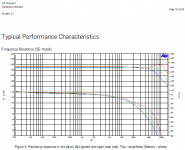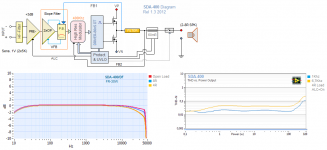greetings fellow countryman.Guys..i've build new diy amplifier.Just make a simple diy used 2x100watt class D 4 ohm...the original amplifier sound good for me..but,i want improve the amplifier with make clarity and sweet vocal...so,what should i do for the next step? what function if put small uF capacitor at the amplifier like 2.2uF or else? where to put it?
An externally hosted image should be here but it was not working when we last tested it.
Uploaded with ImageShack.us
if it's the same board from sure, based on ST's TDA749X then there's probably a magic cap 😀
replace the original ceramic output cap to a good film cap and that should reduce the high frequency distortion quite a bit.
trevmarshall posted the finding here and here.
I am using ICEpower 125asx and 50asx modules in my 4-way active speaker. Looking at this grapf from 125asx datasheet makes me think it has a pre-filter but response tilts over audio band. Dclass driving a transducer directly without any passive components sounds good to me, perhaps most distinctively at very low frequencies (good voice coil control?).
Attachments
Hi,
As many know, I have to agree to a FB post filter in the case of self-oscillating class D, but only in part. especially if my interest is focused on the audio result, instead of the audio measurements perfect.
you can get a good result, especially on the definition and harmonic content of the envelope sound even on a fixed PWM D class.
this shows the trend of the SDA-400 (fixed PWM clock) vs. the load. 1dB from 4R to open load is not bad. certainly is far from the catastrophe that is created when we have changes in 6 .. 10dB.
the slope filter, it really is not an ordinary filter. must be considered as a gain variation via the first FB (pre-filter) in relation to the second FB (this level varies depending on the load).
So I considered 3 parameters A = sound level, B = pre-fb, C = post-fb;
Knowing the behavior in relation to the load / audio frequency, this circuit passes by, positive to negative feedback to ensure linearity of the response.
this is considered an entry-level D class with a good response especially on female vocals and excellent definition of the upper part of the band.
An evolution of this criteria is /F3 amp. a big A-B class with efficiency of class D. 🙂
regards
As many know, I have to agree to a FB post filter in the case of self-oscillating class D, but only in part. especially if my interest is focused on the audio result, instead of the audio measurements perfect.
you can get a good result, especially on the definition and harmonic content of the envelope sound even on a fixed PWM D class.
this shows the trend of the SDA-400 (fixed PWM clock) vs. the load. 1dB from 4R to open load is not bad. certainly is far from the catastrophe that is created when we have changes in 6 .. 10dB.
the slope filter, it really is not an ordinary filter. must be considered as a gain variation via the first FB (pre-filter) in relation to the second FB (this level varies depending on the load).
So I considered 3 parameters A = sound level, B = pre-fb, C = post-fb;
Knowing the behavior in relation to the load / audio frequency, this circuit passes by, positive to negative feedback to ensure linearity of the response.
this is considered an entry-level D class with a good response especially on female vocals and excellent definition of the upper part of the band.
An evolution of this criteria is /F3 amp. a big A-B class with efficiency of class D. 🙂
regards
Attachments
AP2, from what i san see on your block diagram, you have Pre Filter Feedback Self Oscillation(perhaps with a frequency stabilization scheme similar to ChocoHolic's making the switching freq fixed from 0-99% modulation) with post filter AF feedback.
Clocked(fixed frequency) to me is a Triangular Wave Generator feeding one comparator input.
Clocked(fixed frequency) to me is a Triangular Wave Generator feeding one comparator input.
Yes, the SDA (develop in 2005) use trw and comparator locate in pink color block in the diagram. not use the concept of Cocho (i agree it's very good).AP2, from what i san see on your block diagram, you have Pre Filter Feedback Self Oscillation(perhaps with a frequency stabilization scheme similar to ChocoHolic's making the switching freq fixed from 0-99% modulation) with post filter AF feedback.
Clocked(fixed frequency) to me is a Triangular Wave Generator feeding one comparator input.
in last release(1.3) of SDA-400, i have add, AC function on the DC servo (in post filter fb).
I am also using the same amp and i'm pretty satisfied with the quality it produces with dc tone control.
Dc tone control is based on LM1036 which features volume, bass ,treble and balance level controlled by dc voltage.
http://img407.imageshack.us/img407/955/fg9f.jpg
Dc tone control is based on LM1036 which features volume, bass ,treble and balance level controlled by dc voltage.
http://img407.imageshack.us/img407/955/fg9f.jpg
why worry about filters while there are filterless design from TI. It wont measure well but sounds pretty decent. I only hope they comes in higher power version.
why worry about filters while there are filterless design from TI. It wont measure well but sounds pretty decent. I only hope they comes in higher power version.
- Status
- Not open for further replies.
- Home
- Amplifiers
- Class D
- how to make clarity and sweet vocal for class D amplifier?

